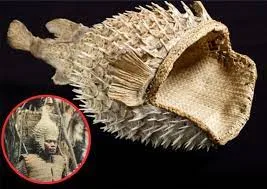Te Barantauti: The Ingenious Hedgehog Fish Helmets of Kiribati
In the 19th century, the warriors of Kiribati, a Pacific island nation, crafted an extraordinary piece of armor known as te barantauti. These helmets, made from the dried skins of hedgehog fish (pufferfish or porcupinefish), were both a practical defense and a striking symbol of ingenuity. By harnessing the natural defenses of their marine environment, the Kiribati people transformed a spiky sea creature into a helmet that was as intimidating as it was protective.

The Hedgehog Fish: Nature’s Armored Gift
Hedgehog fish, known for their ability to inflate and bristling spines, were abundant in the waters around Kiribati. When dried, their tough, spiky skins formed a rigid, lightweight material ideal for crafting. The Kiribati warriors recognized the potential of this natural armor, using the fish’s unique structure to create helmets that could deflect blows and deter attackers. The spines, sharp and durable, added an extra layer of defense, making te barantauti a formidable piece of equipment in battle.
Crafting Te Barantauti
Creating a te barantauti was a testament to the Kiribati people’s resourcefulness. The process involved carefully catching and drying the hedgehog fish, preserving the skin’s natural shape and spines. Artisans would then shape the material into a helmet, often reinforcing it with woven fibers or other local materials to ensure a snug fit. The result was a rounded, spiked headpiece that not only protected the wearer but also projected an aura of menace, leveraging the fish’s natural defenses to psychological effect.

Utility Meets Intimidation
The te barantauti was more than just protective gear; it was a fusion of utility and artistry. The helmet’s spines could deflect or catch weapons, reducing the impact of blows from clubs or spears common in Pacific island warfare. Its fearsome appearance, resembling the puffed-up fish itself, likely served to intimidate opponents, giving Kiribati warriors a psychological edge. This dual purpose—practical defense and visual intimidation—made the helmet a standout example of cultural adaptation to the environment.

A Reflection of Kiribati Ingenuity
The creation of te barantauti highlights the Kiribati people’s deep connection to their surroundings. Living on remote atolls with limited resources, they mastered the art of utilizing what the ocean provided. The hedgehog fish, a creature that might seem unremarkable to outsiders, became a cornerstone of their martial culture. This ingenuity reflects a broader Pacific tradition of transforming natural materials—coconut fibers, shark teeth, and shells—into tools, weapons, and armor.
Legacy of Te Barantauti
While te barantauti is no longer used in warfare, its legacy endures as a symbol of Kiribati’s resourcefulness and cultural heritage. These helmets, preserved in museums and collections, offer a glimpse into a time when survival demanded creativity and a deep understanding of the natural world. They stand as a reminder of how the people of Kiribati turned the ocean’s gifts into tools of strength, blending beauty, utility, and the raw power of nature.


